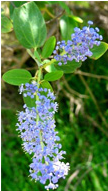 Chaparral whitethorn, which bears the scientific name Ceanothus leucodermis, is a thorny shrub growing erect to heights approaching 12 feet. A member of the buckthorn family Rhamnaceae, this plant despite its thorns is fed upon by several types of ungulate, such as mule deer and bighorn sheep, which eschew its mature or established spines for its tastier and more tender new growth and shoots. Native to California and Baja California’s coastal and inland mountains, chaparral whitethorn is fairly common on dry rocky or sandy slopes to 6,000 feet in chaparral, coniferous forest, and oak woodlands.
Chaparral whitethorn, which bears the scientific name Ceanothus leucodermis, is a thorny shrub growing erect to heights approaching 12 feet. A member of the buckthorn family Rhamnaceae, this plant despite its thorns is fed upon by several types of ungulate, such as mule deer and bighorn sheep, which eschew its mature or established spines for its tastier and more tender new growth and shoots. Native to California and Baja California’s coastal and inland mountains, chaparral whitethorn is fairly common on dry rocky or sandy slopes to 6,000 feet in chaparral, coniferous forest, and oak woodlands.
Sometimes called the California lilac, jackbrush or the ceanothus, Ceanothus leucodermis has pale green or gray-white smooth and waxy bark that is somewhat hairy, especially when new, with short spreading spiny branchlets. The twigs harden into sharp-tipped thorns as they age. The evergreen leaves are alternately arranged, oval in shape and up to about an inch-and-two-thirds long. The edges are smooth or lined with tiny glandular teeth. Leaves are covered with a delicate, white powdery coating that can be rubbed off. Stipules, the small leaf-like structures on the stem at the base of the stem of the leaf, are thin and fall off early, compared to other members of the genus. The inflorescence is a long, stalked one-and-one-quarter inch to three inch long cluster of small but showy flowers in shades of blue, lavender, or white, blooming from April to June. Each flower has five somewhat petal-like, incurved sepals united at the base, and five distinct hooded and clawed petals. There are five stamens opposite the petals.
The fruit is a sticky, three-lobed capsule about half a centimeter long. Fruits do not have horns, as do some other members of this genus.
It has an extensive root system and its root was used by Indians for thread.
SBCSentinel
News of note from around the largest county in the lower 48 states.
